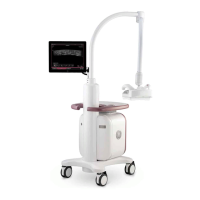Introduction
Invenia ABUS 2.0 – System Setup and Basic Service Manual 5-3
4700-0043-00 Rev. 4
1. Locking Casters
2. Base
3. Dual Box Chassis containing PC Box and Ultrasound Box
4. Weight Tower column
5. Service Table
6. Touchscreen Monitor mounted on Display Arm
7. Scan Arm
8. Hinge
9. Ball Joint (electronically lockable) supporting Scan Head
10. Scan Head with handles, housing Transducer
The following is a quick summary of the key elements and their
major functions:
PC Box
The PC Box contains a system power supply, a PC motherboard
with GPU (graphics processing unit) that image-processes 128
channels of ultrasound data from the cMST board. The GPU
also performs graphics processing for the operator display. The
PC software originates commands sent by USB 2.0 to the
controllers for the Locking Ball Joint, the Scan Head and the
Weight Tower internal motors or solenoids.
The PC Box communicates with the Scan Head Controller over
a USB 2.0 link dedicated for that purpose. This USB cable is
routed from PC to the Ultrasound Box. There its USB signals are
routed in a custom (non USB connector) cable to the Weight
Tower, and from there up the Arm to the Scan Head. A second
PC USB link to the U/S Box is dedicated for Weight Tower
control, and in the same way is connected and routed from the
U/S Box to the Weight Tower.
Ultrasound Box
The Ultrasound Box contains three major electronics boards:
1) the cMST, 2) the MPSB Relay Board (transducer switching
interface), and 3) the MFEPS power supply board with MCI
daughterboard for cables to the Scan Head and Weight Tower
motors and solenoids.
The cMST board handles the ultrasound analog signals,
controls the relays in the MPSB Relay Board, and provides the
control logic for the MFEPS power board. The cMST transfers

